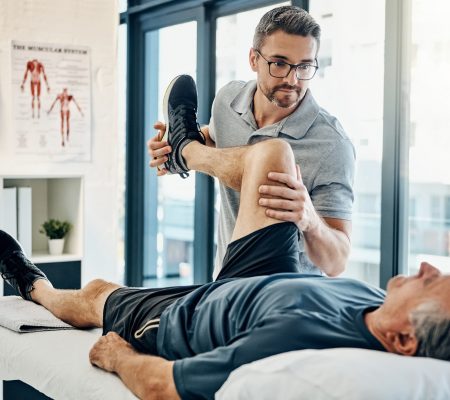5 Reasons Why It’s Critical to Follow Your Physical Therapist’s Directions for Effective Surgery Recovery
We often hear patients wonder if they “really” need to follow their physical therapist’s directions after surgery. The short answer is YES! There is still plenty of healing after surgery takes place, and physical therapy is a critical piece of post-surgical recovery.
After orthopedic surgery, it’s tempting to assume your body will recover on its own. Many patients seem resistant to the idea of physical therapy after surgery. They may have a fear that physical therapy will be too painful, or they may wonder if it’s a necessary part of the recovery process.
There’s no need to worry about discomfort during physical therapy. At the Orthopaedic Hospital of Wisconsin, we always make sure you’re comfortable following your physical therapist’s directions and achieving your surgery recovery goals in a way that feels right for you. We have six outpatient physical therapy locations conveniently located throughout the greater Milwaukee area to encourage our patients to follow through with the entire healing process.
So, if you’re concerned about post-surgical physical therapy, here are five reasons why it’s essential to follow your physical therapist’s directions for full and effective surgery recovery.
1. YOUR THERAPIST WORKS CLOSELY WITH YOUR PHYSICIAN
Physical therapy can be a standalone method for treating an injury, or you can use physical therapy in conjunction with surgery—before surgery (prehab) or after surgery. Either way, physical therapy plays a vital role in helping you return to health after you suffer from orthopedic trauma.
At the Orthopaedic Hospital of Wisconsin, our therapists and physicians work together to ensure they provide each patient with the best care plan. Our orthopaedic surgeons order physical therapy to help patients gain strength in the injured joint’s muscles, increase balance, and reduce recovery time. Erin Woody, a physical therapist at the Orthopaedic Hospital of Wisconsin notes the crucial benefits of this close relationship. She states, “working hand-in-hand with your surgeon allows for consistent communication and ultimately outstanding outcomes.”
plan. Our orthopaedic surgeons order physical therapy to help patients gain strength in the injured joint’s muscles, increase balance, and reduce recovery time. Erin Woody, a physical therapist at the Orthopaedic Hospital of Wisconsin notes the crucial benefits of this close relationship. She states, “working hand-in-hand with your surgeon allows for consistent communication and ultimately outstanding outcomes.”
Our surgeons work closely with our therapists to guarantee the best results for every patient’s surgical recovery. Your physical therapist and surgeon have expertise in treating injuries, and when they put two heads together, they create the best plan of care possible.
2. FOLLOW YOUR PHYSICAL THERAPIST’S DIRECTIONS FOR POST-SURGICAL RECOVERY
One of the most significant benefits of physical therapy is speeding up your recovery time after orthopedic surgery. Faster recovery times are achieved with several approaches, including prehab and post-surgical rehab. The better you are at following your physical therapist’s directions, the easier the recovery.
When you attend prehab, you’ll strengthen muscles surrounding the injured joint before your surgery. When your muscles are stronger to start, it’s easier to regain strength while recovering from your surgical procedure. Ultimately this often reduces the overall recovery time to get back to your normal activities.
People commonly think of physical therapy as a rehabilitative step after undergoing surgery. After serious orthopedic surgeries, such as a total knee or total hip replacement, your bones, muscles, and ligaments are noticeably weaker. When you are on doctors’ orders to rest and recuperate after surgery, it takes a toll on your joint’s strength.
Undergoing rehab post-surgery will increase strength, stability, and range of motion in your joint right away. These gains allow you to get up and get moving safely—with the assistance of a professional who knows your limitations and understands what moves could put you at risk of reinjuring your joint. Woody states, “the goal of physical therapy is always to maximize your physical potential and return you to your activities in the quickest and most pain-free way.”
3. PT HELPS YOU REGAIN STRENGTH, BALANCE AND RANGE OF MOTION
One of the main goals of physical therapy is to help you build strength and balance to reduce pain resulting from an injury. During surgical recovery, it’s often challenging to regain strength and range of motion (ROM) in your injured joint because it takes time to build muscle and restore flexibility.
One of the most effective ways to recover from an injury is by working with a physical therapist who can create an exercise plan tailored specifically to you. Each person is unique and there’s no one-size-fits-all approach. A physical therapist will guide you with instructions for your situation. All of our physical therapists are highly skilled in their profession and experienced in the many ways to help you regain strength, balance, and ROM.
Many people hope they can tackle recovery at home without a professional’s help, but this often delays healing and may even lead to reinjury. Our outpatient physical therapy clinics are built with state-of-the-art equipment to help you regain strength and flexibility effectively. When you start your physical therapy regimen, you’ll quickly learn exercises vary from visit to visit and aren’t possible without professional guidance and specialized equipment.
With the help of a therapist, you’ll continue your surgery recovery journey safely, while avoiding setbacks and additional injuries from attempting rehabilitation on your own. Post-surgical physical therapy gives you the peace of mind to try new activities and provides you with the mental push needed to effectively re-strengthen and stabilize your joint.
4.PHYSICAL THERAPY CAN REDUCE THE BUILDUP OF EXCESS SCAR TISSUE
After surgery, it’s common to have an external scar from the incision, but many patients don’t realize that internal scar tissue may also form. Scar tissue appears in the wound as healthy tissues are damaged, building up over time. During even minimally invasive surgery, layers of skin and tissue are being cut to get to the problem’s root.
Layers of scar tissue naturally begin to form after surgery and create stiffness and pain in the joint. Fortunately, when you follow your physical therapist’s directions, they will help you combat this common effect of surgery to get the best results.
One way to improve scar tissue is through the Graston Technique. In this PT method, therapists use unique instruments to massage the area to aid in the recovery of soft tissues and reduce scar formation. The Graston Technique has a high success rate in lowering pain due to scar tissue, decreasing edema, and increasing range of motion in the healing joint.
A second treatment approach to scar tissue is through the use of Kinesiology tape. Kinesiology tape offers many benefits and aids in the reduction of scar tissue if properly applied. Your therapist will show you how to use the tape to stretch the dermis, fascia, and muscle. This creates blood flow to the scar tissue and slowly stretches out the collagen cells that make up a scar. Your therapist will also help you learn to properly stretch the joint to alleviate pain and minimize scar tissue formation.
5. PHYSICAL THERAPY CAN ENSURE YOU ARE HEALING PROPERLY AFTER SURGERY
After any surgery, your body undergoes a significant recovery process. Complications can arise along the recovery journey, which is why it is essential to attend follow up appointments and physical therapy. It’s a common misconception that patients are healed after surgery, but the truth is surgery is just the beginning of the healing process.
When you visit with your physical therapist post-surgery, they’ll field your questions about the healing joint. They’ll ensure that you are on the correct healing path and help you avoid complications during your recovery. If you do not see a physical therapist regularly after surgery, your joint may heal improperly, and you’ll find yourself experiencing pain in your joint once again. Erin Woody believes that “every patient has the ability to recover completely if given expert guidance and instruction from a skilled physical therapist.”
Physical therapy is a crucial component of your orthopedic injury recovery. It shouldn’t be viewed as an optional activity. After any procedure, your body works hard to heal itself. Give yourself the best outcome by attending your physical therapy appointments and following your therapist’s instructions.
Our physical therapists offer an empathetic approach and a listening ear. They will ensure you’re comfortable with the rehabilitation process and have nothing to fear. It’s natural to feel apprehensive about a new physical activity; we work hard to help you feel safe and at ease.
If you are experiencing an orthopedic injury and think you may need physical therapy, don’t wait. Request an appointment with one of our talented physical therapists today. Following our physical therapist’s directions and instructions will ensure you have a complete and effective recovery.


